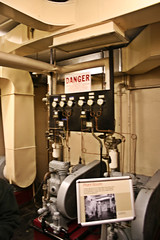
EH's most recently acquired site, at the same time their most historically recent site, is York's Cold War Bunker. This is one of those hidden gems that most people, tourists and locals alike, are completely unaware of. Nestled behind a posh housing estate, this hump of grass goes completely ignored by those who don't already know what it is. It cost EH £250,000 to preserve the site and make it safe for visitors, and apparently there was not much money left for pr activities.
The bunker was in use by the Royal Observer Corps (ROC) from the 1960s until the end of the cold war in 1991. The ROC was a civilian group set up originally in WWII as a nationwide network for spotting enemy planes. By the 1960s, planes were too quick to be spotted by the ROC, so they were assigned the task of recording and reporting nuclear bombs dropped on the UK. The technology in the bunker achieved few upgrades since the 1960s, so one interesting aspect of the tour is to see how people would be expected to work together as a team of 20 in a small office to triangulate the positions of bombs, calculate the distribution of radioactive material and report these positions to central authorities with barely any computer technology.
The bunker also has a more human interest to it. A video presentation, as well as the rooms of the bunker itself, calls on you to imagine how life would have been for ROC members working in the midst of a real nuclear crisis, should one have occurred. Upon hearing the sirens, most of the 120 ROC members local to the bunker would have left their families behind and run to the bunker in an effort to be one of the first 60 people to arrive. Only the first 60 ROC members at the gate were to be allowed in.
Once in, ROC members would try to cleanse themselves of radiation using an everyday bathroom sink. From then on they would be stuck inside the cramped underground rooms for up to 30 days, sleeping in noisy dorm rooms with bunk beds, eating ration packs in a tiny canteen and working long shifts in a tiny office. The information they received about the outside world would be censored by their officer. No family photographs were allowed on the premises. The air conditioner was only to be used in short bursts, as nobody knew how well or how long the filter would work against radiation, so the whole place would be incredibly stuffy. Every couple of hours somebody would have to go out and brave the potentially radioactive outside world in order to retrieve a pinhole camera from the roof that would record any further explosions. The tank containing clean water was the most vulnerable part of the structure in case of a nearby nuclear explosion, so radiation poisoning through water use was also a real possibility. The entrance doors were not blast proof, and it was simply hoped that the few walls standing between the office and the entrance would be enough to absorb a nuclear blast.
The bunker is a poignant reminder of how close we came to disaster, and a unique perspective on the fragility of the systems we had in place to cope with a nuclear attack. It's a unique attraction and definitely worth checking out, although it took a decent meal and a strong coffee to help up recover afterwards.
No comments:
Post a Comment